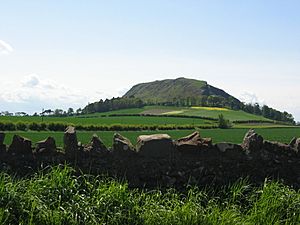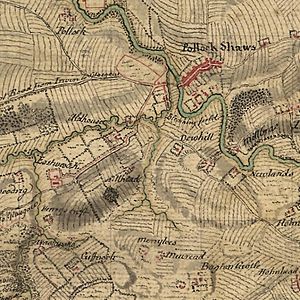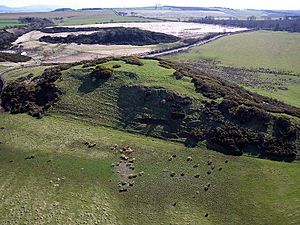Hillforts in Scotland facts for kids
Hillforts in Scotland are ancient settlements built on high ground. They often had strong walls made of earth, wood, or stone. These forts were like mini-cities where people lived and protected themselves.
People first started studying these forts in the 1700s. Serious research began in the 1800s. In the 1900s, archaeologists dug up many sites. They wanted to figure out when these forts were built and how they changed over time.
Hillforts first appeared in Scotland during the Bronze Age, around 1000 BCE. Most of them are from the Iron Age. There are over 1,000 Iron Age hillforts, mostly in the southern part of Scotland. Many were left empty when the Romans came to Britain.
You can also find many vitrified forts. These are forts where the walls have been burned, making them look like glass. Many of these might also be from the Iron Age. After the Romans left, some hillforts were used again. Smaller forts, like those at Edinburgh and Dunbarton, became important centers for local kingdoms.
Contents
Discovering Ancient Forts
One of the first big studies of Scottish hillforts was by General William Roy. His book, The Military Antiquities of the Romans in Britain, came out in 1793. Roy mainly looked at forts that were near Roman buildings. He sometimes even thought native forts were Roman!
Later, George Chalmers wrote Caledonia in 1807. He listed many forts. He realized that forts like Burnswark were built to defend against local threats, not just the Romans. He also saw how some main forts were connected to smaller ones. They could often see each other from a distance.
In 1851, Daniel Wilson was the first to use the word "pre-historic" in English. But he didn't think hillforts were very important. The first real fieldwork in Scotland was done by David Christison. He surveyed many hillforts before 1894. His book, Early Fortification of Scotland (1898), became a guide for future studies.
In the 1900s, many digs helped scientists understand when forts were built. They tried to create a timeline of defenses. C. M. Piggott's work at Hownam Rings was very important. He suggested that forts became more complex over time. They started with simple wooden fences (palisades). Then they got single stone walls (univallate). Later, they had multiple walls (multivallate). Finally, people stopped using defenses and built stone houses.
This idea was later challenged by Peter Hill. He found that stone houses might have been built even before the Romans arrived. With new carbon dating methods, scientists learned that the history of hillforts was more complicated. But the idea of forts growing more complex and then being abandoned is still partly true.
Types and Uses of Hillforts
A. H. A. Hogg identified four main types of hillforts. These are contour forts, promontory forts, cliff forts, and ridge forts. Contour forts are the most common in Scotland. Their walls and ditches follow the shape of the hill.
Promontory forts are less common. They use natural features like cliffs, often along the coast. The biggest one in Scotland is at the Mull of Galloway.
The way forts were built changed over time. They used different mixes of earth, stone, or wood. Wood was often filled with stone. In Europe, wood was often placed upright. But in Scotland, horizontal timbers were more common.
People used to think hillforts were mainly for defense. But in recent years, experts have started to think they had other uses too. They might have been important social, religious, or ceremonial places.
Bronze Age Forts
Bronze tools and weapons started to be made in Scotland around 2000 BCE. This was also when the first hillforts appeared. Some had wooden fences, while others had ditches and earth walls.
One example is Eildon Hill near Melrose. Around 1000 BCE, hundreds of houses were built on this fortified hilltop. Traprain Law in East Lothian had a large enclosure. It was made of a stone wall with a rubble core.
Castle Rock in Edinburgh and Burnswark also have forts from this time. Some forts were much smaller, only big enough for one or two families. Experts still debate if these forts were mainly for fighting or if they were important centers for communities.
Iron Age Forts
Around 700 BCE, people in Scotland started working with iron. There are about 1,000 Iron Age hillforts in Scotland. Most are south of the Clyde-Forth line. They are usually round, with a single wooden fence around them.
Many of these forts were left empty when the Romans arrived. This might be because large forts were easy targets for the Romans. But some were used again after the Romans left.
There are also many vitrified forts from this period. Their walls look like glass because they were burned. For a long time, people thought this burning was done on purpose to make the walls stronger. But now, we think it happened when forts were destroyed. This could have been after a battle or when people left the fort.
For example, a fort at Finavon Hill was destroyed around 200 BCE or 500 CE. Another fort at Dunnideer was destroyed between 500 and 250 BCE.
Early Medieval Forts
After the Romans left in the 400s CE, new forts appeared. Warfare was very common in early historic northern Britain. So, these hillforts were probably built for defense. Some became the main centers for different kingdoms.
These new forts were often smaller than Iron Age ones. They often used natural features for protection. Edinburgh Castle was likely the main fort for the Gododdin kingdom. Dunbarton Rock was the center of the kingdom that ruled the Strathclyde area.
The people of northern Britain built different kinds of forts. The type of fort depended on the land, the building materials available, and their military needs. Bridei mac Maelchon, an early Pictish king, had his base at Craig Phadrig near Inverness. The Gaelic kingdom of Dál Riata was probably ruled from the fortress of Dunadd.




